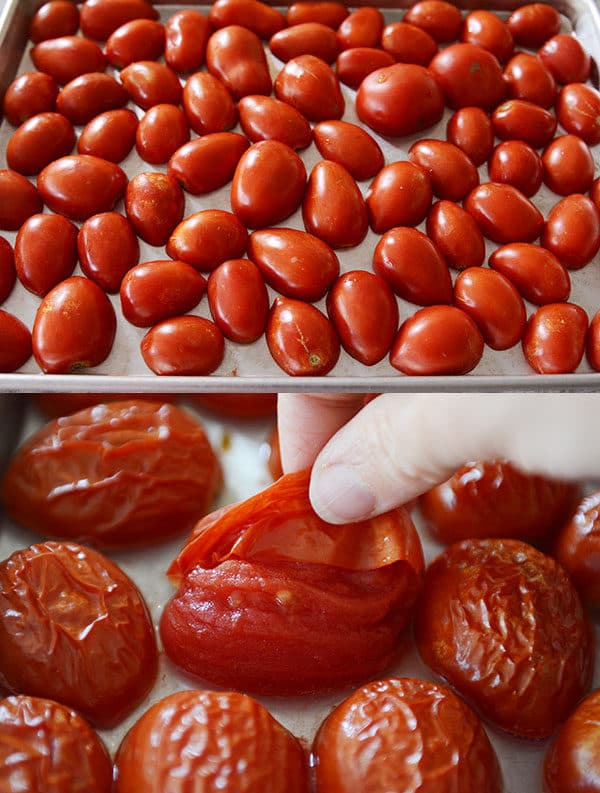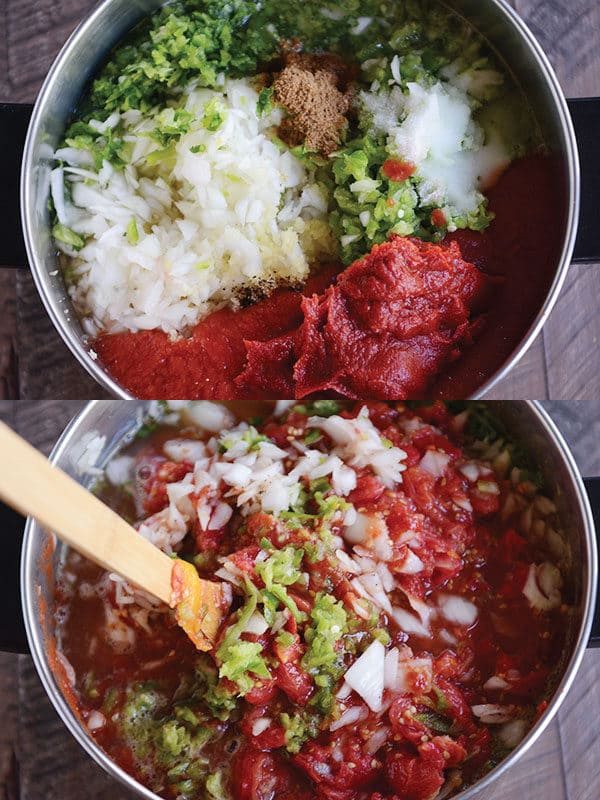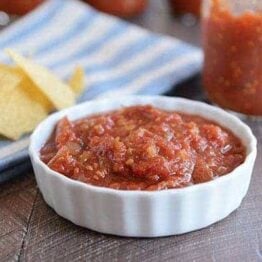A step-by-step canning guide to the best homemade salsa on the planet! This is the only salsa I make because it is perfect for eating right away and even better when canned and put on the shelves to enjoy all year long.
I’ve been wanting to share it for a long time and finally put a step-by-step canning guide together for those that are new to canning or hesitant to try it (spoiler alert: it’s easy, and I really mean that).
With perfectly balanced flavors, somehow this salsa has become my go-to – both for canning and for eating right away.
It is fantastic and I’m always asked for the recipe when I decide to part with a jar.
I used to kind of roll my eyes at people who got heated (no pun intended) over which homemade salsa recipe is the best (most of the aforementioned people don’t give out their secret recipes so I’ve had to end my friendship with them).
Now that I have The One, I have started to understand the passion, excitement and drama surrounding salsa.
I’d pretty much arm wrestle anyone who is willing just to prove that this is the best salsa ever.
Of course, I’d lose (wimpy arms) so we’d have to settle it over a taste test, and I am 100% more confident in that test than in the arm wrestle results.
The acid ingredients in salsa help preserve it. You must add acid to canned salsa because the natural acidity may not be high enough. Commonly used acids are vinegar and bottled lemon juice. Lemon juice is more acidic than vinegar and has less effect on flavor.

Making and canning salsa is definitely not hard, but there are a few things to keep in mind:
1) Use a tested recipe. Canning is a great and fun (yes, I’m a nerd) way to preserve food and keep it on your shelves, but there are many food safety concerns related to canning and it’s important to use a recipe that’s been tested to ensure the pH levels are safe over time.
2) The variety of tomatoes doesn’t necessarily matter for this recipe, but the method does. This recipe calls for draining the peeled, chopped tomatoes and you’ll definitely want to follow this step otherwise your salsa will be watery.
3) Peeling tomatoes is the pits, but it must be done for this recipe (both from a texture and bacteria standpoint). I know my grandmother will roll in her grave, but I don’t use the traditional cut an X in the tomato, plunge it into boiling water and then submerge in an ice bath method.
Instead, I cut the tomatoes in half, place them cut-side down on a baking sheet, pop them under the hot oven broiler for 3-4 minutes (watch closely!) and the skins will wrinkle right up when the pan is removed, and after they are cooled, the skins will peel off really easily.
It’s brilliantly simple and has made me get over the dread of peeling tomatoes; it’s the only way I do it.

4) When it comes to my step-by-step guide below, I have used a steam bath canner to process the salsa. Disclaimer: Even though I prefer to use a steam bath canner (and so do lots of other home canners), many people and resources say there isn’t enough research about steam canners to know if they are safe enough to use.
So do your research and keep in mind that a water bath canner can definitely be used instead.
You’ll find a lot of information for both sides of the debate, so decide what feels right to you. I’m certainly not saying a steam canner is the only way to go.
UPDATE: Thanks to Janet in the comments for letting me know steam canners HAVE been approved by a national extension office and the National Center for Home Food Preservation for processing times under 45 minutes (here’s the article).
There are lots of other details and notes down below in the homemade salsa recipe and the step-by-step picture guide below, so make sure to read thoroughly and feel free to ask any questions in the comments.

Mostly, I want you to know that canning salsa is easy (and therapeutic; seriously, I love canning) and even more than that, this may be the only salsa recipe you’ll ever need.
As written, it’s not spicy – just perfectly balanced with all the delicious flavors of salsa. If you’ve been on the hunt for the perfect salsa recipe, this is it, baby.
So if you have homegrown tomatoes or know where to find some (please ask before you pick), this homemade salsa should be top on your list of recipes to make. I hope you love it!
*several products below are affiliate links to Amazon where I’ve bought the product from
- this over-the-sink colander is awesome for draining the tomatoes
- my trusty Breville food processor (love of my life after I had two Cuisinart food processors die sudden deaths on me) does all the chopping
- steam canner
- this simple canning toolset has just about everything I need for filling and handling the jars

UPDATE 09/06/17: Lots of you have asked for a weight measure on the tomatoes. I’ve been canning this salsa the last few days and experimented weighing and measuring tomatoes. The result? Tomatoes are unpredictable! Meaning, the exact weight (that will yield the 10 cups drained needed in the recipe) is EXTREMELY variable depending on the type of tomato used.
When I used a combination of Roma/paste tomatoes and everyday garden tomatoes (don’t know the exact variety, but in this batch, Romas probably made up about 1/3 of the total amount of tomatoes), I needed almost six pounds of tomatoes to equal 2 1/2 cups of drained tomatoes. That’s because my non-paste tomatoes have a ton of liquid that drains off. Today, I measured 2 pounds of JUST paste tomatoes (about 12-14 small to medium Romas from my garden) and after taking the skins off, crushing lightly and letting drain, I had a little over 1 cup of drained tomatoes to use for this salsa. I do tend to err on the side of over-draining, as an FYI.
I’ll add notes to the recipe and in the comment thread below. Basically, a lot will depend on the variety of tomatoes you have and you should really just use the weight measure as a guideline since it may vary quite a bit.

The Best Homemade Salsa
- 10 cups peeled, chopped and drained tomatoes (see note)
- 3 cups chopped onion
- 1 ¾ cups chopped green bell pepper
- 5 medium jalapeños, finely chopped, membranes and seeds removed (leave in for extra spice) – about 1 to 1 1/4 cups
- 7 cloves garlic, finely minced
- 2 ½ teaspoons ground cumin
- 2 ½ teaspoons coarsely ground black pepper
- 2 ½ tablespoons canning or pickling salt (see note)
- ⅓ cup chopped fresh cilantro
- ⅓ cup sugar, optional, depending on sweetness of tomatoes
- 1 ¼ cups apple cider vinegar (see note)
- 16 ounces tomato sauce, NOT optional – necessary for safe canning/proper pH
- 12 ounces tomato paste, optional if you want a thicker salsa
- Combine all the ingredients in a large pot and bring to a boil. Reduce the heat and simmer for 10 minutes, stirring often.
- Fill sterilized pint-size canning jars within 1/2-inch of the top. Wipe the rim of the jar clean and seal with a lid and ring.
- Process in a water or steam bath canner for 15 minutes (add 5 minutes if you live at 1,001 to 3,000 feet; add 10 minutes for 3,001 to 6,000 feet; add 15 minutes for 6,001 feet to 8,000 feet).
- Remove the jars carefully from the water or steam bath and let cool to room temperature. Check to make sure the jars have sealed correctly (lightly press the top of the lid; it should be firm – if the center bubbles up and down when you press on it, it hasn’t sealed correctly and will need to be refrigerated or re-processed).
Recipe Source: adapted slightly (increased all the quantities appropriate for canning safety) from this recipe I found on the awesome GardenWeb site
CANNING FRESH HOMEMADE SALSA / STEP BY STEP INSTRUCTIONS WITH RECIPE / POSITIVELY AMY
FAQ
What happens if you forget to put vinegar in your salsa?
Does vinegar make salsa last longer?
Why does Mexican restaurant salsa taste so good?
Do you use vinegar or lime juice in salsa?
Is white vinegar good for salsa?
White vinegar is perfect for adding a little sharpness to your salsa, and it’s also a great way to balance out the flavors. 2. It’s a natural preservative. White vinegar is a great way to help preserve your salsa, so you can enjoy it for longer. 3. It’s perfect for all types of salsa.
What are the benefits of drinking vinegar?
Drinking vinegar or apple vinegar has been said to reduce cancer risk, cure cancer as well as have anti-inflammatory, antimicrobial and antibacterial effects. In addition, vinegar is also said to help clear your skin and promote healthy hair growth. Unfortunately, to date, no clinical studies have been able to conclusively prove these benefits.
Can you use cider vinegar to make salsa?
It has a low pH, so it helps to keep the salsa fresh and prevents it from spoiling. Cider vinegar also adds a slightly sweet and tangy flavor to the salsa, which can help to balance out the spices and herbs. If you want to make your own salsa at home, try using cider vinegar as a natural preservative.
Does vinegar make salsa roja?
No, vinegar is not an ingredient used to make authentic Mexican salsa or salsa roja. Tomatoes are already acidic and vinegar is a strong sour ingredient that would only make the salsa more acidic and not in a good way. A little bit of lime juice however, adds a hint of fresh citrus flavor without overpowering it or making the salsa astringent.
